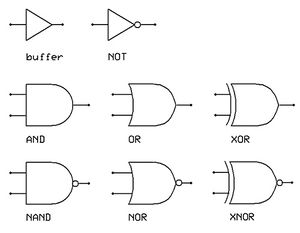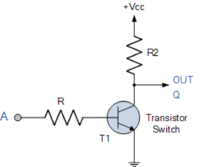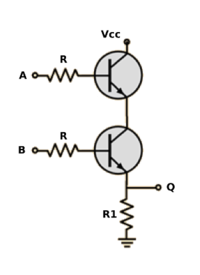Digital-Electronics Obstacle Course
Permanent Materials (located in the electronics area):
- power supplies
- function generators
- oscilloscopes
- Fluke 179 multimeter (MM)
- capacitance meter
- electronic proto-boards
- wire, resistors, capacitors, inductors, diodes, Op-Amps, other ICs
Materials to borrow when necessary
- LTSpice circuit simulation software (on computers in lab)
- lab copy of The Art of Electronics, Horowitz & Hill
- inductance meter
- Keithley voltage supply
Activities
- Read chapter 8 of Horowitz & Hill's The Art of Electronics.
- Read Chapters 10 and 11 of Keith Brindley's eBook Starting Electronics.
The inverter or NOT gate
- Using T1 = TIP31C, R = 10k, R2 = 1k, Vcc = 10VDC construct the circuit shown at the right.
- Apply 0V to input A. What's the output Q?
- Apply 10V to input A. What's the output Q?
- Taking 0 (or close to zero) volts to be logic state "0" and 10 (or close to ten) volts to be logic state "1" construct the logic state truth table for this circuit (see right).
- What type of logic gate does the truth table indicate?
- Letting the input = A and the output = B write a Boolean statement describing this NOT gate (i.e., Q = ???).
We can also use the "True" and "False" representation of digital logic with a "0" state equated with a "False" value and "1" state equated with a "True" value.
The OR gate
- Using two 2N4401BU transistors with R = 10k, R1 = 4.7k and Vcc = 6VDC construct the circuit shown at the right.
- Apply 0V to A and 0V to B. What is Q?
- Apply 1V to A and 0V to B. What is Q?
- Apply 0V to A and 1V to B. What is Q?
- Apply 1V to A and 1V to B. What is Q?
- Construct a truth table for this circuit.
- What type of logic gate does the truth table indicate?
- Letting the input = A and the output = B write a Boolean statement describing this OR gate.
The AND gate
- Using two 2N4401BU transistors with R = 10k, R1 = 4.7k and Vcc = 6VDC construct the circuit shown at the right.
- Apply 0V to A and 0V to B. What is Q?
- Apply 1V to A and 0V to B. What is Q?
- Apply 0V to A and 1V to B. What is Q?
- Apply 1V to A and 1V to B. What is Q?
- Construct a truth table for this circuit.
- What type of logic gate does the truth table indicate?
- Letting the input = A and the output = B write a Boolean statement describing this AND gate.
It should be clear that we could follow the OR gate with a NOT gate and get a NOT OR gate (a NOR gate).
We could follow an AND gate with a NOT gate and get a NOT AND gate (a NAND gate).
In addition, there are other basic gates like the XOR (exclusive OR) and the XNOR (exclusive NOR).
An OR gate outputs "True" when either (or both) of its inputs is "True". However, an XOR gate outputs True (we'll drop the quotes) when either of its inputs is True (but not both). The XNOR gate is a combination of an XOR gate and an inverter (a NOT XOR gate).
It would be extremely tedious (though in principle possible) to build every logic circuit from discrete transistor elements. There are dedicated digital ICs that perform these logic functions.
- The 7400 series digital ICs. These are 5V TTL (transistor-transistor logic) devices.
- Th e4000 series digital ICs. These are CMOS devices.





